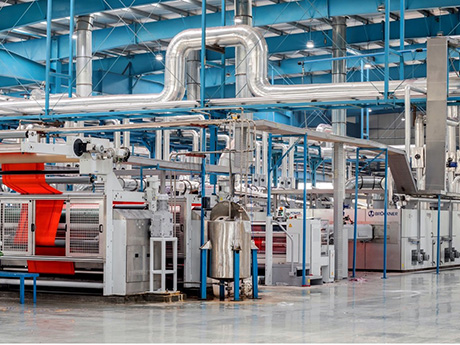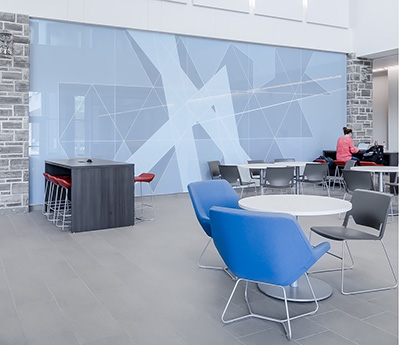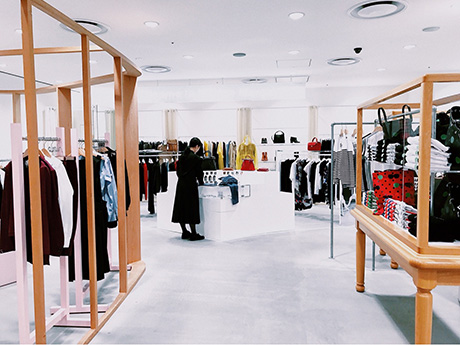Slower absorption and rent growth plagued industrial, office and multifamily asset classes across the United States in the third quarter, as outlined in Lee & Associates’ 2023 Q3 North America Market Report. Some regional exceptions were able to buck the overdevelopment trend, but retail was the only property type to avoid the quarter’s shift toward rising vacancy rates. High interest rates, slower rent growth and fear of overbuilding have contributed to lower construction starts in every sector.
The full Lee & Associates report is available — including breakdowns of factors like detailed vacancy rates, inventory square footage, cap rates outlined city by city, market rents and more — here. The analysis below provides an overview of industrial, office, retail and multifamily real estate sectors alongside sector trends, economic background as well as geographic exceptions within each property type.

Photo by Lalit Kumar on Unsplash.
Industrial Overview: Absorption Continues Slowing, Inventories to Spike
Demand for industrial space remained positive in the United States in the third quarter, but growth this year has lost steam compared to strong net absorption totals of the last two years.
U.S. net growth in the third quarter totaled 29.9 million square feet compared to 94 million square feet for the same period last year. Year-to-date net absorption is 110.2 million square feet, down 62 percent from the same period last year. There was 411.7 million square feet of growth in 2022. The 524.7 million square feet of net absorption in 2021 stands as the record, but the current pace of tenant expansion is the slowest since 2012 and comes as a quarterly record of new inventory is set for delivery.
Nearly 200 million square feet of new stock is slated for completion in the fourth quarter, a quarterly record. U.S. inventory is set to grow by more than 3 percent in 2023, marking the fastest pace of supply growth in more than three decades. The new supply due from the development pipeline will likely drive up the national vacancy rate in 2023 and 2024. Onshoring of high-tech manufacturing is set to be a key driver of demand from 2024–26. Across the 87 U.S. markets in Lee & Associates’ survey, there are 527 million square feet of projects underway. Most are unleased and set to be completed within 12 months.
Construction starts have been dropping since last fall, with some developers growing anxious that higher interest rates may cause values of newly delivered projects to dip below replacement costs. Since peaking at 11.5 percent in mid-2022, year-over-year rent growth has been decelerating and stands at 7.4 percent. Further deceleration in rent growth seems unavoidable in 2024, given that landlords will be contending with a record tally of new space while high interest rates weigh on the economy.
The recent absorption slowdown was broadbased across most markets, but Los Angeles, the Inland Empire and Seattle recorded outsized increases in space being listed as available for lease among existing properties. While imports have been declining at the national level since November, slowing has been most pronounced at major West Coast ports where cargo flows have been negatively impacted by a threatened strike by dockworkers. They recently reached a tentative agreement on a new contract. Markets including Tampa, Jacksonville, Milwaukee and Detroit have bucked the national trend and recorded tightening availability rates year to date in 2023. Jacksonville and Tampa have been direct beneficiaries of rapid in-migration and the continued diversion of Asian imports through the Panama Canal to East Coast and Gulf Coast ports. Milwaukee and Detroit have benefitted from limited or fast-declining levels of speculative construction, coupled with continued expansions by manufacturing tenants and distributors.

Photo by Scott Webb on Unsplash.
Office Overview: Markets Plagued by Chronic Weak Demand
The general fear of COVID has long subsided and hospitalizations are 92 percent down from the peak. But remote work and hybrid schedules seem entrenched despite companies’ get-tough/return-to-office measures. North American office occupancy remains stuck at roughly half the levels prior to COVID. Other downturns have shaken demand for office space but never so fundamentally as the fallout from the coronavirus lockdown.
In the United States, tenants shed 15.4 million square feet of space in the third quarter, bringing the year’s negative net absorption total to 55 million square feet. That is equal to record losses through September of the first year of the pandemic and was unexpected as this year’s contraction follows two years of improved demand.
Total occupancy in the United States is at its lowest level since 2017, despite a 12 percent increase in office-using workers. Leasing activity this year is 15 percent below pre-pandemic levels. New leases average 20 percent less space. Additionally, the quantity of occupied but available space is more than 50 million square feet above its historical norm, having risen steadily since mid-2020. Calculated in the aggregate, today’s users require about 440 million square feet less than current employment levels suggest.
This reality has sent the ratio of needed space per worker plummeting to 8 percent below what it was entering 2020, accelerating a decade-long trend of shrinking space-per-worker requirements. Stagnant demand is likely to linger, and space-per-worker requirements may shrink further, recent market dynamics suggest. This is consistent with two trends: Large tenants are reducing their footprints when existing leases fall in, and the flight to quality by many users skews the composition of the prospective tenant toward those with smaller requirements.
First-generation premium buildings have seen consistently positive net absorption. These typically offer unique benefits to tenants, including top-tier locations, designs and amenities, more natural light and better environmental performance. Since early 2020, these properties have seen an average of 14 million square feet of positive net absorption per quarter. On the other hand, a similar number of older properties have found little appeal. Buildings representing only about 15 percent of leased, non-medical inventory account for over 120 million square feet of negative net absorption just in the past 12 months.
There could be much more pain to come for landlords as the balance of pre-2020 leases – still a majority – approach expiration. Also, there are 215 million square feet of sublease availability, a breathtaking amount that has risen more than 130 percent since the end of 2019. The current total is nearly 80 percent above its previous peak during the Great Recession.
This extreme polarization is prolonging uncertainty about the future of the sector. If tenant leasing behavior holds to its recent form, the fallout could be quite severe outside the narrow slice of inventory that is still attracting occupancy.
Retail Overview: Demand Continues; Recession Postponed Again
Demand for retail space across North America has remained resilient through the first three quarters of 2023 with healthy economic growth in the United States confounding expectations of a recession.
Net absorption in the United States through the third quarter is positive, albeit about 25 percent behind average growth of the last two years. Overall vacancy rates fell to all-time lows across the United States in the third quarter, but some merchants looking to expand may receive relief soon. In the United States, about 30 million square feet are scheduled for completion by April.
While moderating from the multi-decade high pace seen near the end of 2022, asking rents in the United States continue to rise at a healthy clip due to minimal availability and the significant boost in retail sales coming out of the pandemic. Asking rents for retail spaces in the United States are up an average of 3.5 percent over the past year to a record $24 per square foot.
As the supply of competitive available space has dwindled, stronger pricing power is being enjoyed by landlords who predictably are more selective with new tenant signings and holding firmer in lease negotiations. Economists have been warning of recession for more than a year as the Fed has raised interest rates to fight inflation. Most U.S. leasing activity remains concentrated in spaces smaller than 3,000 square feet and overwhelmingly is driven by growth from quick-service restaurants. The food-and-beverage sector accounted for nearly 20 percent of all leasing activity over the past year. Starbucks, Crumbl Cookies, Yum Brands and Restaurant Brands International, which owns Burger King, Tim Hortons, Popeyes and Firehouse Subs, are among those opening the most locations this year.
Demand for medium to larger spaces has been primarily driven by discounters Dollar Tree, Dollar General and its pOpshelf concept, Philadelphia-based Five Below and others. TJ Maxx, Burlington, Ross and other off-price merchants also have been active. Demand for spaces larger than 10,000 square feet increasingly has come from fitness and experiential tenants. The greatest uptick in demand for space has occurred in Sun Belt markets, which are experiencing growth in population and buying power. Leading the way over the past year, as retail follows rooftops, were Phoenix, San Antonio, Austin, Fort Lauderdale and Kansas City.
Restoration of fundamental balance in retail markets has been due to the limited amount of construction activity. A near-historic low of about 50 million square feet of space was delivered in the past year. Deliveries primarily have consisted of build-to-suits, grocery-anchored centers or smaller retail spaces in large mixed-use projects. More than 16 million square feet of retail space have been demolished in the last four quarters, resulting in net deliveries of 36.7 million square feet, which is near the historic low. Developers and local municipalities have razed more than 150 million square feet of retail space since 2016 with a significant portion of this stock consisting of vacant department store boxes and defunct malls.

Photo by Brandon Griggs on Unsplash.
Multifamily Overview: Vacancy, Rents; North America’s Bifurcated Markets
Despite strong tenant demand in the United States for the second straight quarter, the surge of new apartments emerging from the development pipeline continues to outpace demand, resulting in a sharp increase in vacancies and the lowest rent growth on record.
More than 1 million multifamily units are under construction in the U.S., the most since the early 1970s. Even though 288,059 apartments have been leased this year – 22 percent more than the annual average in the decade prior to COVID – 401,344 new units have been completed and about 136,000 are set for delivery in the fourth quarter of 2023. More than 440,000 units are projected for delivery in 2024 and 334,849 units in 2025. Since mid-year 2021, the U.S. vacancy rate has increased from 4.6 percent to 7 percent. In the last six quarters, rent growth has fallen from 10.9 percent to 0.9 percent at the end of the third quarter.
Construction starts have fallen dramatically this year — a result of higher interest rates, lower rents and what looks like overbuilding in several markets. The result is that fewer than 160,000 units are forecast for completion in 2026 and an estimated 194,000 in 2027.
Many markets are at risk of oversupply, especially in the Sun Belt, reflecting the significant acceleration of development activity in that region responding to strong in-migration during the pandemic. Since 2019, deliveries in Sun Belt markets have increased 64 percent while they are up by only 8 percent in the rest of the nation.
Mid- and high-rise buildings comprise the majority of new developments, a transition from earlier years when new multifamily developments were mostly garden-style apartments. Conversion of office buildings to multifamily units has been a trending topic in commercial real estate circles. Because older office buildings with smaller, rectangular floorplates are preferred, it is estimated that only some 15 percent of buildings are architecturally suitable candidates for conversion. About 10,000 converted units could be delivered this year. While this number may grow over the next few years, the overall impact will remain a small percentage of the bigger development picture.
Fifteen U.S. markets are projected to hit new record deliveries in 2023. Sun Belt locations dominate this list. Austin expects 19,000 new units to be delivered this year, more than in Atlanta but with half the inventory. But the added inventory combined with demand, put a number of these markets at risk of worsening supply/demand imbalances.
The top five rent growth leaders were Cincinnati, Northern New Jersey, Columbus, Indianapolis and Chicago. At the same time, Austin and Las Vegas anchor the bottom of the pack with year-over-year rents down by 3.4 percent. Palm Beach posted the steepest rent slowdown. Annual rent growth fell from 28 percent at the end of 2021 to 0 percent this year. In Las Vegas, rent growth slowed from 21 percent to 3.3 percent over the same period.
— Lee & Associates Research Department. Lee & Associates is a content partner of REBusinessOnline. To read all of 2023 Q3 North America Market Report, click here.
Retail photo by Lalit Kumar on Unsplash.


